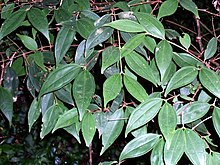Rhodamnia rubescens
| Rhodamnia rubescens | |
|---|---|

| |
| Rhodamnia rubescens at Elvina Bay, Australia. | |
| Scientific classification | |
| Kingdom: | |
| (unranked): | |
| (unranked): | |
| (unranked): | |
| Order: | |
| Family: | |
| Genus: | |
| Species: | R. rubescens
|
| Binomial name | |
| Rhodamnia rubescens | |
| Synonyms | |
|
| |
Rhodamnia rubescens (scrub stringybark, brush turpentine, brown malletwood) is a rainforest tree of eastern Australia. Identified by a stringy type of bark and three veined leaves, it grows in a variety of different rainforests from the Batemans Bay region (35° S) of southeastern New South Wales to Gympie (27° S) in southeastern Queensland. It is not seen in the cool temperate rainforests.
Description
This small to medium tree can attain a height of up to 25 metres (82 ft) and a trunk diameter of 75 centimetres (30 in). It produces a bark that is reddish brown, brittle, scaly and "stringy", similar to the turpentine. Its base is channelled, fluted or somewhat buttressed.
The leaves are simple, not toothed, opposite on the stem, pointed, elliptical in shape, and around 5 to 10 centimetres (2.0 to 3.9 in) long. They are clearly three veined with net venation visible on both sides, downy underneath and have a greyish colour. The oil dots are transparent and visible with a hand lens. The tree's small branches are scaly with the same reddish bark as the trunk; the new shoots are covered in minute hairs.
White fragrant flowers form on panicled cymes from August to October. The fruit is a small berry, initially red then turning to shiny black as it matures from October to December. The berries can measure up to 6 millimetres (0.24 in) in diameter. The fruit is eaten by various birds, including the brown cuckoo dove, figbird, green catbird and rainbow lorikeet. Removing the seed from the fleshy aril is advised to assist germination.
References
- Floyd, A.G., Rainforest Trees of Mainland South-eastern Australia, Inkata Press 1989, ISBN 0-909605-57-2 page 257
- Rhodamnia rubescens at NSW Flora Online Retrieved on 12 July 2009
